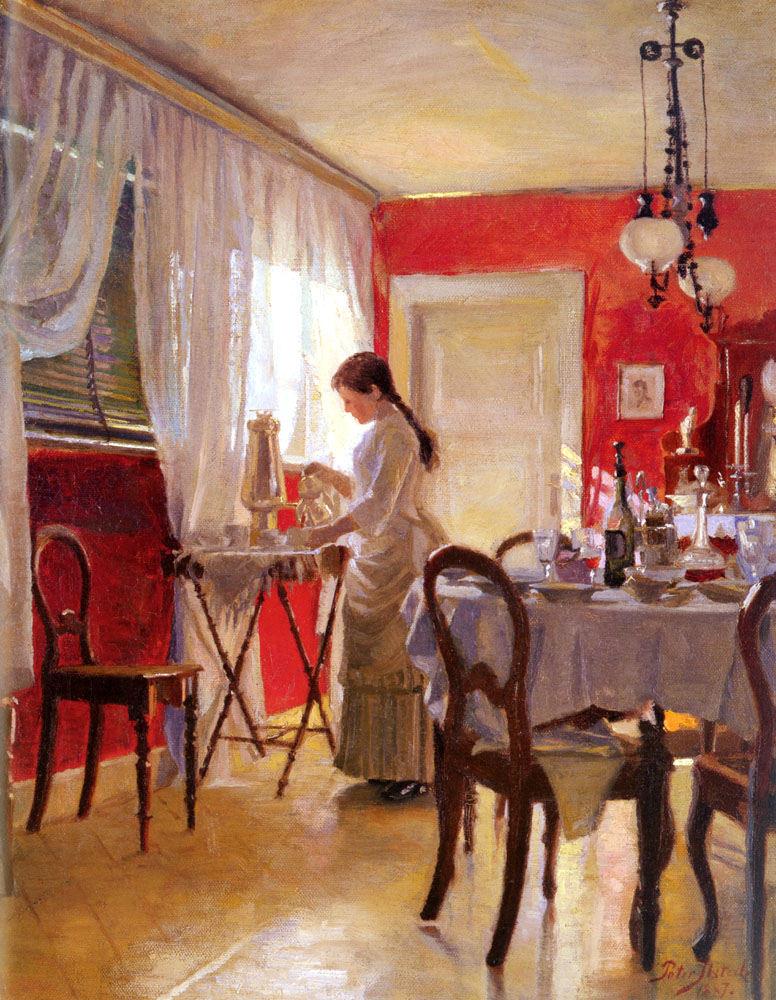The Industrial Revolution changed the world in many ways. It brought capitalism and consumerism into being, changing the world’s outlook on wealth creation. It revolutionized technology, allowing the innovation of mass production to expand exponentially. Jobs in factories shifted labor from farming to factories. With this came the migration of people from countrysides into cities as the economy shifted from an agrarian society into an industrialized society. This shift altered the social structure of the family. Beginning in the early nineteenth century, as the effects of the Industrial Revolution began to settle, a pattern became visible. With the rise of industrial labor, men transformed their function from director of work to provider of income, developing their role in the public sphere as laborers and professionals. Meanwhile, women took on the role of educating the children and keeping the home in order, forming the private sphere within the household.1
Historians argue over how we should understand these separate spheres. Some argue that working-class women had to participate in the public sphere out of necessity for earning a living, and therefore they were denied the choice of participating in the cult of domesticity.2 They argue that although these women’s position in society was marginal, they created an identity for themselves in the public sphere.3 While these historians claim that participation in the cult of domesticity was restricted to middle-class women, I argue that working-class women, when they had the choice, often chose to work in the private sphere, thereby choosing to participate in the cult of domesticity to the best of their abilities.

As the Industrial Revolution changed the mold of society, the public sector and the private home became two isolated and separate worlds. The private sphere of influence that women were associated with in the nineteenth century refers to the realm in which a woman’s role was as the head of the domestic household. In contrast, men participated in the public sphere, which included the worlds of labor, politics, and association.4 In her role in the private sphere, a woman determined the social reproduction aspect of the family, as opposed to the economic production. Social reproduction is defined by feminists as the labor involved in the maintenance of a lifestyle as well as producing the next generation.5 This work goes beyond bearing children, including activities such as making food, clothing, and shelter immediately available; teaching and caring for children; caring for the elderly; and providing a good moral example within her home.6 From an early age, girls’ education centered around making good wives and mothers with programs that guaranteed gentility and femininity. By participating in such activities, women helped to form the organization of society through their families. While the class of their families contributed to the flexibility of their appearance in the public sphere, there is a clear distinction between public and private worlds.
The newly formed middle class of the nineteenth century is the most overwhelming indication of the separation of spheres. With industrialization on the rise, clear gender roles emerged as the social structure of the family changed.7 Whereas in the working class both women and men contributed to the family income, in middle-class families the men worked for wages while their wives stayed home to manage the household.8 This gave women of the middle class little opportunity to participate in the public sphere. A clear indicator of middle-class status was the ability to keep any number of servants. Most families had only one servant.9 Nevertheless, it was the women of the household that directed their work in their homes. This was the contribution they made to their household. The occupation of homemaker, though valuable to the family, cemented their lives in the private sphere. Mothers were expected to provide for the education of their children. It was because of this ideology that middle-class women were able to be educated in math, literature, history, and foreign language, and to teach their children in turn.10 As daughters grew up, the limited education they received was the basis for wives and mothers to properly fulfill their roles, teaching their children as the cycle of domesticity repeated itself.

Due to their economic need to work, working-class women had more of an opportunity to be in the public sphere. In order to survive, these women, as laborers, interacted with employers, landlords, police, and other public institutions such as schools.11 This blurred the line between the private and public spheres. It was for this reason that working-class women were seen as hostile and aggressive. Although they did have interactions in the public sphere, this conflicted with their assigned role as caretakers. In order to do what was necessary to provide for their families, they were perceived as risking their moral virtue by entering the public sphere. With this morality at stake, it was easy for society to question these women’s ability to care for a household when the private and public spheres were viewed as being so isolated from each other. Thus, being employed in a factory, or another public institution was viewed as unfavorable to working-class families seeking jobs for their daughters. These daughters were to grow to become the wives and mothers of the next generation, so they needed to be viewed with the capability to support domesticity. Therefore, when women had the choice, these young women often chose to be employed as a servant, which was a less humiliating alternative to factory work.12
These young, working-class women helped their families by earning income while remaining in the private sphere. Their class status remained distinctly working class, as it was the distinction to hire a servant in the first place that separated the middle class from the working class. But even when a working-class daughter or wife needed to contribute to the family’s income, if she chose to work as a domestic servant, her could remain largely in the private sphere, although in the private sphere of another woman’s home. An 1891 study shows that out of the 772 domestic servants working in Lancaster, only eight were men.13 Clearly there is an overwhelming difference in number of female servants as opposed to male domestics. Thus, by the Victorian standards that fostered the separate spheres sensibilities, these working-class women were subsequently choosing to remain in the private realm. The same study shows that the majority of servants were young single women. This indicates that these women were preparing for their lives as wives and mothers by supporting their father’s household through work in a private home.14 It further shows that young women worked in factories and entered the public sphere only when absolutely necessary.

Through the examinations of the work that women of the lower and middle classes contributed to their families, there is a clear distinction that emerged in contrast to their husbands and fathers. While middle-class women dedicated their lives to their work in the privacy of their homes, working-class women were required to roam the male-dominated public sphere by working. Still, a clear distinction emerges, as working women often chose jobs in the homes of the wealthier classes. Through this evidence, I have argued that women most often sought to remain in the private sphere, either as middle-class women or as working-class servants, while their husbands and fathers worked to provide for their families economically. Therefore, despite the claim that participation in the restrictions of the private sphere pertained only to the middle class, it is clear that working-class women often chose to work in the private sphere rather than in the public eye.
- Barbara Laslett and Johanna Brenner, “Gender and Social Reproduction,” Annual Review of Sociology, vol. 15 (1989): 387. ↵
- Amanda Vickery, “Golden Age to Separate Spheres? A Review of the Categories and Chronology of English Women’s History,” The Historical Journal, vol. 36, no. 2 (June 1993): 389. ↵
- Ruth L. Smith and Deborah M. Valenze, “Mutuality and Marginality: Liberal Moral Theory and Working Class Women in Nineteenth Century England,” Signs, vol. 13, no. 2 (winter 1988): 278. ↵
- Ellen Jordan, “‘Making Good Wives and Mothers’? The Transformation of Middle-Class Girls’ Education in Nineteenth-Century Britain,” History of Education Quarterly, vol. 31, no. 4 (Winter 1991): 443. ↵
- Barbara Laslett and Johanna Brenner, “Gender and Social Reproduction,” Annual Review of Sociology, vol. 15 (1989): 385. ↵
- Ellen Jordan, “‘Making Good Wives and Mothers’? The Transformation of Middle-Class Girls’ Education in Nineteenth-Century Britain,” History of Education Quarterly, vol. 31, no. 4 (Winter 1991): 442. ↵
- World History Encyclopedia, 2011, s.v. “The Cult of Domesticity in the United States and Britain.” ↵
- Barbara Laslett and Johanna Brenner, “Gender and Social Reproduction,” Annual Review of Sociology, vol. 15 (1989): 389. ↵
- Siân Pooley, “Domestic Servants and Their Urban Employers: A Case Study of Lancaster, 1880-1914,” The Economic History Review, New Series, vol. 62, no. 2 (May 2009): 407. ↵
- Ellen Jordan, “‘Making Good Wives and Mothers’? The Transformation of Middle-Class Girls’ Education in Nineteenth-Century Britain,” History of Education Quarterly, vol. 31, no. 4 (Winter 1991): 442. ↵
- Ruth L. Smith and Deborah M. Valenze, “Mutuality and Marginality: Liberal Moral Theory and Working Class Women in Nineteenth Century England,” Signs, vol. 13, no. 2 (winter 1988): 286. ↵
- Siân Pooley, “Domestic Servants and Their Urban Employers: A Case Study of Lancaster, 1880-1914,” The Economic History Review, New Series, vol. 62, no. 2 (May 2009): 418 ↵
- Siân Pooley, “Domestic Servants and Their Urban Employers: A Case Study of Lancaster, 1880-1914,” The Economic History Review, New Series, vol. 62, no. 2 (May 2009): 411. ↵
- Siân Pooley, “Domestic Servants and Their Urban Employers: A Case Study of Lancaster, 1880-1914,” The Economic History Review, New Series, vol. 62, no. 2 (May 2009): 411. ↵



63 comments
Francisco Cruzado
I liked the argument of the article. I would have liked, though, seeing data on the percentage presence women in the working force and on the main rhetorical expressions that were made during the Victorian era in regards to the despising of the factory work as a feminine labor. The literature of Jane Austen is sort of a great example of the latter, I would say, but I am sure that there have to be better sources on the expressiveness of the idiosyncrasy of the time. It is always shocking to remember, however, that a political and legislative institution, as it was the England of the XIX century, could build such a system in which they forced women, or at least the greatest number, to think in a certain manner, and aspire for certain standards, turning them docile, submissive, and invisible at the eyes of the other peoples
Francisco Cruzado
I liked the argument being made in the article. I would have liked, though, seeing data on the percentage presence women in the working force and on the main rhetorical expressions that were made during the Victorian era in regards to the despising of the factory work as a feminine labor. The literature of Jane Austen is sort of a great example of the latter, I would say, but I am sure that there have to be better sources on the expressiveness of the idiosyncrasy of the time. It is always shocking to remember, however, that a political and legislative institution, as it was the England of the XIX century, could build such a system in which they forced women, or at least the greatest number, to think in a certain manner, and aspire for certain standards, turning them docile, submissive, and invisible at the eyes of the others.
Michael Leary
Very interesting article, it made me think about how the Industrial Revolution changed middle-class societal roles. I enjoyed reading about this and found it very informative and allowed for a look into how households were run during the Victorian period. It is interesting to see how the public and private sectors were split at that time, but, seem to be coming back together over the past few decades with more woman in the workplace and an increased role of the father in the lives of his children.
Tala Owens
This was a very very interesting article to read. It really shed light on how even working class women sought out to work in a more private setting because of how society viewed them and their role in a family, household, and marriage. Girls had their lives planned out for them since birth and it always included being in a the private setting of their home and being a housewife. It’s sad that those who needed to take care of themselves and families and worked in the public at factories and such were viewed negatively. It really shows how women were constantly being looked at and judged for everything they did back then.
Victoria Salazar
Wow, this article was truly fascinating and incredible. Although we don’t always think of “housewives” as a very powerful role for a woman, this article shows that it is. Without the private world that women are taught to create from the time they are young girls, there would be no public sphere for the men to form. Although the separation of classes is not an idea I agree very much with in general, I am glad that the formation of the middle class allowed for more people to prosper.
Danielle Slaughter
I appreciated that this article was one of opinion, and it was rather aesthetic at that, with a wonderful use of images! I do consider myself a feminist, so I ventured into this article with trepidation – but to my pleasant surprise, I came away with a newfound respect for this period of industrialization, especially for the working-class women. They had no choice but to head out to work, but instead of toiling away in a factory or the like, they elected to remain as close to the domestic sphere as possible by taking on jobs as maids. You wrote a very informative article that offered a glimpse into a little-thought-of world.
Engelbert Madrid
Honestly, this is quite an interesting article that looks back at the gender roles of both men and women in the Industrial Revolution in England; however, it takes a further understanding of the different spheres of working-class and middle-class women due to financial income. In the public spheres, working-class women had the opportunity to work and collaborate with men, while middle-class couldn’t. Although this is an opinion article, I think it’s a great article to learn about the roles of women during the Industrial Revolution.
Christopher Hohman
Nice article. The role for women in the Victorian and Edwardian age was quite different than what it is today. Women of that time were charged with raising the family and keeping a good house. Some women worked, but even then they usually worked in the private sphere as a servant or maid. It is so funny because now I feel that both the mother and father in today’s family play an active role in their children’s life, a departure from the family unit just one century ago. I think that is a good thing though because families can spend more time together than before.
Sofia Resendiz
Learning about women’s role in society during the Industrial Revolution was very interesting. When learning about the Industrial Revolution I thought that there was an increase in the amount of workers needed. Therefore providing an opportunity for women to work in the factories. However it is sad to learn that most women decided to conform to the private realm and work within the confines if a home.
Emily Jensen
Reading about the Public sphere and the private sphere was really interesting; it never occurred to me that men and women led such separated lives. It was natural for women to be taught to be the caretakers while the men were encouraged to work to support their families. I liked how the author laid out what historians typically believe, but then shared her belief and supported her argument with facts. Well done!